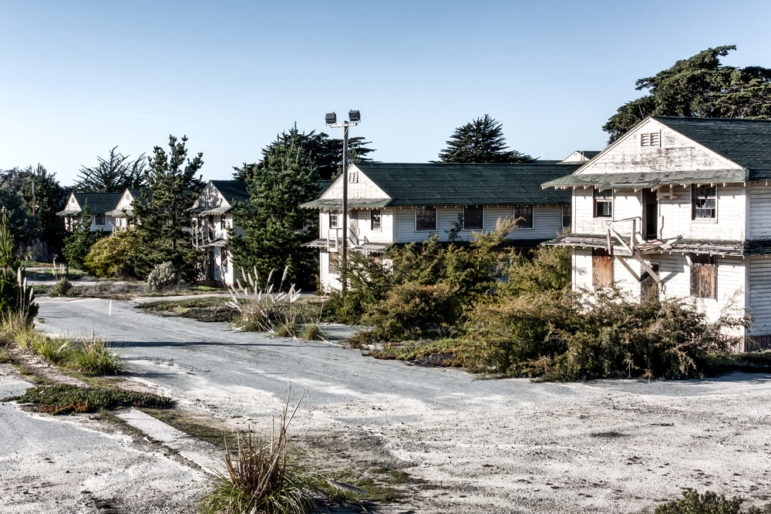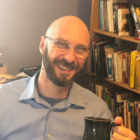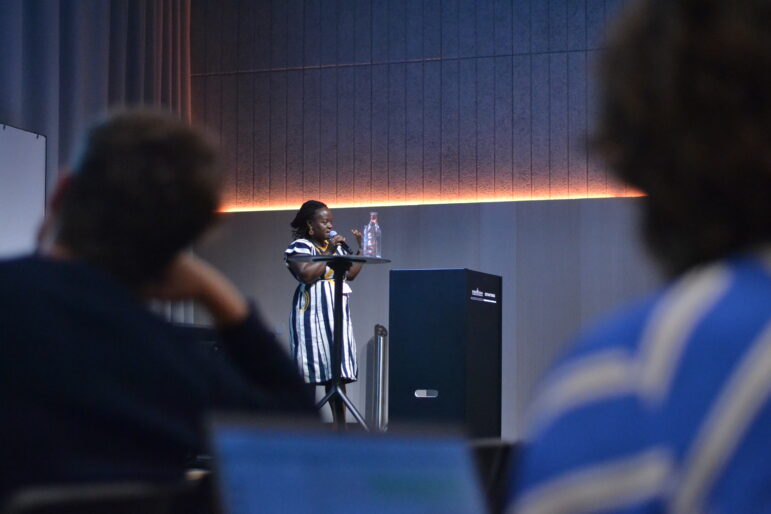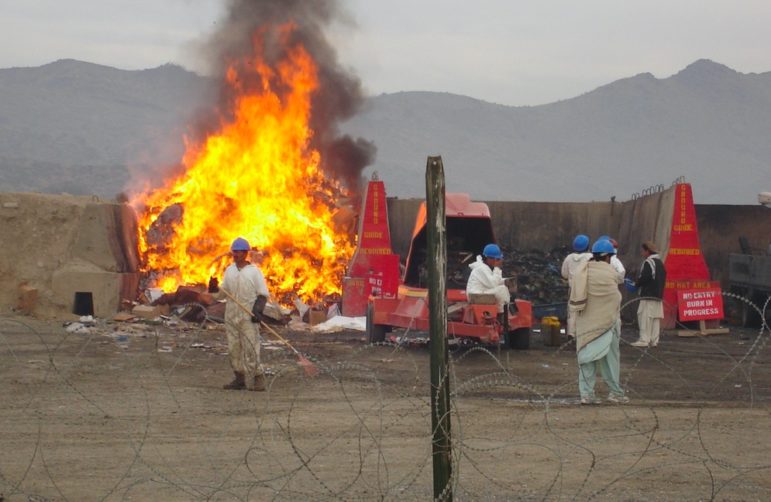

Investigating Toxic Military Bases and Their Links to Cancer

Abandoned barracks at the decommissioned Fort Ord US Army post in Monterey, California. Image: Shutterstock
Old military bases around the world offer the potential for a powerful question from investigative journalists: Do former base residents suffer higher rates of cancer, and can this be linked to reckless contamination from chemicals or weapons over the years?
Three Associated Press reporters believe their year-long investigation into a former military base in the United States represents a useful model for how journalists can tackle these projects at other old or decommissioned bases.
Published in February 2022, the What Lies Beneath project found an alarming history of cancer-causing pollution at Fort Ord, a US Army post on California’s Monterey Bay, south of San Francisco. Reporters found a toxic legacy at the base, ranging from “burn pits” and fire-retardant foam to residue from ordnance and weapons training and toxic cleaning solvents. With the help of numerous sources, the AP team also compiled a database of about 400 former residents who have since developed cancer, including rare cancers, and also found that veterans from the area have a 35% higher rate of multiple myeloma — bone marrow cancer — than the general US population.
In addition, the investigation found that the US Army knew that dangerous chemicals were dumped on the California site for decades, that officials downplayed serious health risks to new residents, and that civilian contractors were warned to stay silent about toxins they found in the drinking water.
The core reporting team comprised investigative journalists Jason Dearen, Juliet Linderman, and Martha Mendoza, who has won two Pulitzer prizes.
“US military bases all over the world have contaminated their groundwater, and they know it,” says Mendoza. “This story can be replicated by foreign journalists looking at their own bases.”
She added: “If you look at Ukraine — unfortunately, maybe in 20 years, you might find an environmental disaster there.”
The US alone maintains an estimated 800 military bases in more than 70 countries.
A major army base until 1994, a large portion of Fort Ord’s land has since been turned into a nature conservation area, while a small portion remains a military facility.
The story summarizes the base’s pollution history this way: “Recruits tossed live grenades into the canyons of ‘Mortar Alley,’ sprayed soapy chemicals on burn pits of scrap metal and solvents, poured toxic substances… into leaky tanks they buried underground. When it rained, poisons percolated into aquifers from which they drew drinking water. Through the years, soldiers and civilians… didn’t question whether their tap water was safe.”
Tackling the Causation Problem
Like other classic environmental illness investigations — such as linking diseases to prior lead paint exposure — projects tying cancers to military veterans or their families face the “correlation versus causation” problem. Rarely is it possible to prove that exposure to chemical contamination caused later illnesses in individuals.
Linderman says this can easily dissuade reporters from digging into rare diseases associated with even the most obviously polluted military sites.
But — as this investigation demonstrates — correlation can be enough to achieve impact on these topics, if the data set is big enough, and the reporting is thorough in the three key areas of evidence: the science, the victims, and the site. The AP exposé was widely republished, and triggered urgent calls for a federal study of harm from two US Members of Congress.
Toxic chemical dumping and burning at coalition military bases in conflict-affected countries like Afghanistan, Somalia, and Iraq have also been linked to mass illness, and experts say large bases in almost any country could pose similar risks. In early August, the US Congress passed legislation to fund medical care for ill veterans who were exposed to burn pits in combat zones. Notably, the legislation bypassed the causation problem by presuming the link between the dumping or burning of toxins and subsequent diseases.
Nevertheless, that link remains a broader challenge for journalists. With this in mind, Linderman says the AP team tackled the problem with a new strategy: a sharp division of labor among the reporters. Dearen focused on the science behind chemical pollution and the various cancers, Linderman was responsible for interviewing sick veterans, and families of those who died, and Mendoza dug through documents about the base and also spent time at the site, talking to witnesses and collecting her own soil and water samples.

AP investigative reporter Juliet Linderman visits abandoned barracks at Ford Ord, which once housed many soldiers who now suffer from rare cancers. Image: Courtesy of Martha Mendoza
“Usually, a team just has a long to-do list – you do this, you do that – and collaborations are often ‘all of us do all of it,’ but this approach was much better,” explains Mendoza. “By really dividing it up, we each developed expertise in our focus area. Jason did all the environmental toxicology – asking, ‘What would being exposed to these chemicals in your drinking water do to your body?’ Juliet developed very close relationships to people with cancer – in one case, going to a victim’s doctor’s appointments, meeting with her family.”
The team found that sick veterans from the base did not qualify for compensation for health risks due to a 1996 health assessment report from the Centers for Disease Control and Prevention (the CDC), which concluded that “there were no likely past, present, or future risks from exposure.”
However, that study relied wholly on the military’s own water quality data. In addition, Dearen found that it was published prior to several modern research findings about the links between exposure to toxic chemicals and cancers.
For instance, he found that a degreaser compound called TCE that was widely used on the post has since been found to be a human carcinogen – and even that the foam once used by firefighters to douse burn pit fires contained chemicals like PCB that are now linked to disease.
Human and Data Sources
While it doesn’t qualify as evidence, belief turned out to be an important narrative and contact-building element for the investigation. The reporters found hundreds of veterans who simply believe that their sometimes rare disorders are linked to their time at Fort Ord years ago.
One former soldier at the base, Julie Akey, was determined to find out why she — with no family history of blood cancers — had developed multiple myeloma at the age of 46. She launched a Facebook group for sick base veterans and their family members, which currently has more than 700 members, and found many examples of rare cancers with no genetic history.
Akey’s Facebook group became a crucial resource for Linderman’s contacts, and she says social media searches for veterans groups are a key starting point for military contamination investigations.
“Most of the people in our database have been in touch with Julie [Akey], and because she was the administrator of this universe, her help was central,” says Linderman. “Organizers like this can say ‘This person has a really compelling story,’ or ‘This guy is never going to talk to you.’” She added: “These people feel like they don’t have a voice, and that no one is paying attention to them. I think it’s important to understand the individuals suffering this way.”

The AP investigation What Lies Beneath. Image: Screenshot
Dearen says chemicals associated with the maintenance of military aircraft, in particular, emerged as a red flag for health risk.
“If you’re a reporter with an old air force base in your neck of the woods, it’s worth looking into contaminants there,” says Dearen. “Because they used all of these sprays, and also foams for crash landings that had all these chemicals like PCBs and TCEs.”
In the US, more than 1,400 contaminated sites — from commercial mining sites to landfills to Ford Ord – have been identified for health studies and long-term cleanup operations by the Environmental Protection Agency (EPA), as part of its Superfund mandate.
However, Dearen notes that the sheer number of toxic sites generated by the 1980 Superfund law in the US often results in underfunded, outdated, or compromised studies.
“They created this agency that was stretched so thin that they couldn’t really tell the danger,” he explains. “So I knew the context, and I knew the CDC study was probably done hastily, using the military’s own data. That’s like a prosecutor asking a defendant to hand over their emails showing they did something wrong.”
Dearen adds: “A lot of people don’t realize this, but the main thing to know about Superfund sites is the government always designates a keeper of the Superfund site data, and a lot of times that’s a local library.”
Linderman says small-town librarians proved to be important for the Ford Ord investigation, and that librarians, in general, are underused document sources for investigative reporters around the world.
“Never underestimate how helpful librarians can be — these people are knowledgeable and often bored, and they are so excited that someone is interested in their archives,” she notes. “They let us hang out all day; we got their phone numbers, and they said ‘Call us for whatever you need.’”
Mendoza says she took about 40 water and soil samples while moving around the site on foot and by bicycle.
“I can blend in — look a lot like just a mom, filling something with a hose for the family,” she says with a chuckle. “Generally, you can, as a civilian, be on a military base. We were in the parks, hiking and biking around, taking samples, talking to the people.”
However, Linderman says the final published story did not include the lab results from Mendoza’s samples. Instead, she says results from newsroom-gathered samples can help guide further questions and document searches — and that, with hindsight, the team should perhaps have partnered with a university science team to preserve the evidence.
“We had trouble with the sample evidence because we’re not scientists — because it could have been contaminated before we tested,” she says. “ A good piece of advice is to pay attention to a scientific methodology and partner with a local university.”
The AP team ultimately spent 12 months on the Fort Ord story, which drew national attention. The reporters came away with a number of tips for journalists digging into cancer-causing contamination at military bases:
- Don’t be dissuaded by old health risk assessments, and challenge their findings through interviews with current researchers.
- Use the free Google Earth Pro tool – and its timeline slider feature — to look for evidence of prior pollution. This includes black smoke plumes from open-air burn pits and trenches for chemical dumping.
- Divide core reporting roles between questions about the science, the victims, and the site, and share highlighted notes and updates in communal files on tools like Google Drive.
- Seek out firefighters and aircraft mechanics, in particular, as potential sources.
- Seek permission to examine patients’ medical records and accompany one or two on doctor’s visits. However, be careful to set expectations for these victims, and explain your role as a reporter carefully.
- Search social media for veterans groups affected by chronic illness, and attend veteran forums and public meetings.
- Develop a large database of sick veterans, and tell the story of a handful of former residents that illustrates their struggles.
- Talk to librarians in the towns near military bases, and look for archived transcripts of public meetings and copies of clean-up contracts.
- Consider taking your own soil and water samples, but be sure to partner with local universities or scientists before on-site collection.
“When you’re writing stories that are really technical and deal with things you can’t really see, like persistent illnesses, it’s always good to find human faces that people can care about right now,” says Linderman.
Ultimately, these investigations are more about sick and worried people than toxic chemicals, Linderman explains, so reporters need to be especially careful in dealing with victims.
“An important point to remember is that, for them, their individual story is the most important thing in the world,” she says. “If you talk to someone for an hour, and they’re crying on the phone, later they might say, ‘Well, I shared all of this vulnerability with you, and I’m not even in the story.’ It’s heartbreaking to hear. Also, victims often think journalists are their mouthpiece. You have to adjust their expectations – and don’t make promises you can’t keep.”
Additional Resources
Investigating the ‘Toxic Legacy’ of Abandoned Oil Wells
Powering Up Geo-Journalism for Investigative Environmental Reporting
Remote Sensing and Data Tools for Environmental Investigations
 Rowan Philp is a reporter for GIJN. He was formerly chief reporter for South Africa’s Sunday Times. As a foreign correspondent, he has reported on news, politics, corruption, and conflict from more than two dozen countries around the world.
Rowan Philp is a reporter for GIJN. He was formerly chief reporter for South Africa’s Sunday Times. As a foreign correspondent, he has reported on news, politics, corruption, and conflict from more than two dozen countries around the world.










